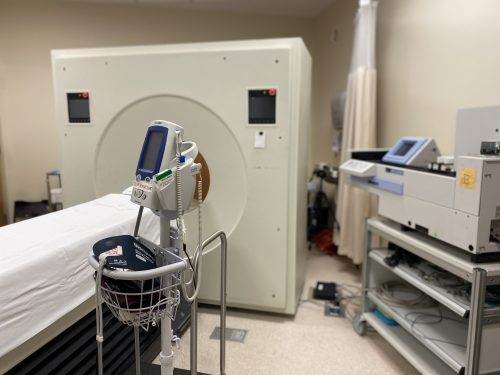Image courtesy of Grace Macdonald.
Throughout history, alcohol has been enjoyed as a source of personal relaxation, a delightful accompaniment to meals, and a social lubricant. What happens when your preoccupation with alcohol becomes so intense that it inhibits your daily activities, reaching “chronic disease” level?
The options are limited; only three pharmacotherapies are approved by the U.S. Food and Drug Administration for the treatment of alcohol use disorder (AUD): disulfiram, acamprosate, and naltrexone. Of these, naltrexone is the mildest: effective but without the harsh and nauseous side-effects of disulfiram. However, naltrexone’s efficacy varies greatly from person to person, and as a result, physicians hesitate to prescribe naltrexone, doing so only 13% of the time.
At Yale School of Medicine, Professor Evan D. Morris and his team are collaborating with Professor Suchitra Krishnan-Sarin’s team to investigate possible ways to moderate naltrexone treatment such that higher therapeutic efficacy is achieved. “How can we identify people where it will or won’t work?” asks Bart de Laat, as associate research scientist at the Morris lab.
Normally, when we drink alcohol, our brain releases endorphins and dynorphins, naturally produced proteins that then bind to opioid receptors, producing the feelings of pleasure that are commonly associated with intoxication. Naltrexone is a nonselective opioid receptor antagonist, meaning it mimics the molecular structure of these proteins and competes with them for binding to each of the three opioid receptor subtypes: mu, delta, and kappa. By interrupting the pathway in this way, naltrexone can decrease the pleasure and rewarding effect of alcohol that promotes heavy drinking in individuals. However, recent research suggests that the kappa opioid receptor (KOR) plays a larger role in naltrexone’s effect than previously thought. The lab hypothesized that KOR availability could modify the effect of naltrexone, as well as feelings of cravings.
In this study, forty-eight non-treatment seeking heavy drinkers were recruited to participate in two alcohol drinking paradigms (ADPs) designed by Dr. Krishnan-Sarin and her team: one before naltrexone administration and one after 7-8 days of naltrexone. Subjects first consumed a priming alcohol drink, were monitored for 50 minutes, then engaged in three self-administration periods. Participants were offered a choice between consuming up to four of their favorite mixed alcoholic drinks or receiving $3 for each drink declined. Afterwards, they were monitored over-night at the Hospital Research Unit and discharged the next morning. Participants received progressively stronger doses of naltrexone throughout the next six days before finally repeating the ADP setup. By introducing a small monetary reward each time that they declined a drink, researchers set up what de Laat describes as a “dynamic changing of relative value.” De Laat studies participants’ behaviors: “How high is your craving? How high is your motivation? At what point is your motivation for $3 higher than your craving?” Their results show that participants by-and-large reported lower levels of craving and accepted fewer drinks in the second ADP post-naltrexone.
Participants also received two PET (positron emission tomography) scans, one before naltrexone and one two hours after the last naltrexone dose. Researchers injected a radioactive tracer that was designed to attach to the endorphin associated with the KOR. By monitoring the radioactive signal given off by the brain, they could quantify how many kappa receptors were present and available throughout various brain regions. Important findings arise from comparing the two PET scans: “In the beginning you injected the tracer and it could just happily bind to every receptor it finds—now it can’t because there is a lot of naltrexone bound to the receptors, so it kind of has to look for a longer time, or it doesn’t find a free spot at all,” De Laat said. With fewer kappa receptors available, the radioactive signal coming from the brain decreases. The larger this decrease is, the more effective naltrexone was in this individual.
Ultimately, researchers discovered a negative association between KOR availability and efficacy of naltrexone. A greater reduction in drinking was observed in individuals who had lower KOR availability, whereas individuals with high levels of KOR throughout the brain received less optimal results from naltrexone. This implicates KOR availability as a crucial factor in continued craving after naltrexone therapy.
How can these results be utilized to predict naltrexone efficacy in certain individuals on a large-scale? “With this information you try to tease apart groups, or individuals, and that is the first step to personalize medicine,” de Laat said. Correlating high or low occupancy of KOR with efficacy of naltrexone paves way to developing improved treatments for alcoholism.
Citations:
de Laat, Bart, Alissa Goldberg, Julia Shi, Jeanette M. Tetrault, Nabeel Nabulsi, Ming-Qiang Zheng, Soheila Najafzadeh, Hong Gao, Michael Kapinos, Jim Ropchan, Stephanie S. O’Malley, Yiyun Huang, Evan D. Morris, and Suchitra Krishnan-Sarin. “The Kappa Opioid Receptor Is Associated With Naltrexone-Induced Reduction of Drinking and Craving.” Biological Psychiatry 86, no. 11 (December 1, 2019): 809-10. doi.org/10.1016/j.biopsych.2019.05.021.

